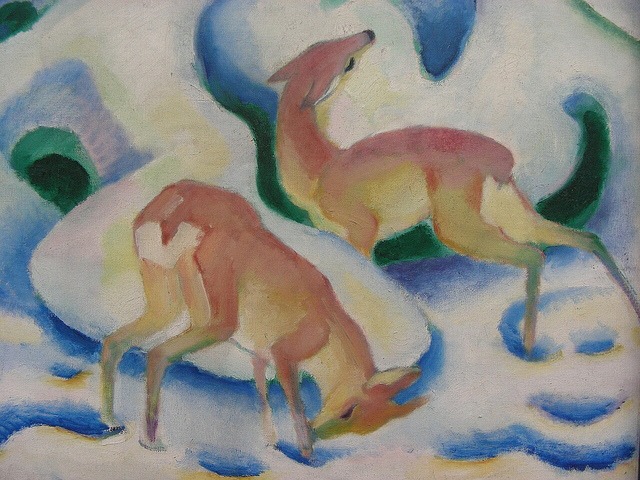
by Jean Marie Carey | 29 Aug 2015 | Animals, Franz Marc, German Expressionism / Modernism
My 2012 M.A. thesis, Franz Marc as an Ethologist, is now part of the online collection of the open-access Social Science Research Network (SSRN). You can download it or look at the abstract here.
UPDATE: I just can’t with Elsevier’s involvement with SSRN. In addition to Elsevier being generally evil, not supporting open access, and ruining the Pergamon imprint, more than a year after acquiring SSRN, there is still no discrete art history rubric, or way for authors to track who is looking at their work. But mainly Elsevier is garbage.

Franz Marc, Rehe im Schnee II, 1911, one of Marc’s paintings discussed in my thesis.

by Jean Marie Carey | 9 Jun 2013 | Art History, German Expressionism / Modernism

There were opportunities during Isabelle Graw’s presentation this past week at the Lenbachhaus to make some some site-specific comments about the collections at hand, and Graw did make tangential connections to work by Joseph Beuys and Wolfgang Tillmans, thought not those which belongs to the museum’s Kunst Nach 1945 collection.
Intensely and yet breezily theoretical (I have heard Graw speak several times, on one of those occasions dismissing the Adorno-Horkheimer ‘culture industry’ works most art historians spend their lives trying to understand as insufficiently complex for her needs in explaining the reification of art) Graw is an engaging speaker, readily admitting that many of her contentions create oppositional paradoxes which thus cannot be argued against. Graw herself occupies dual roles, as professor for Art Theory and Art History at Staatliche Hochschule für Bildende Künste in Frankfurt am Main and as an art critic and co-founder of Texte zur Kunst, the respectable but for-profit Berlin art journal. Graw also has a heavy amount of street cred coming from a lengthy association with Martin Kippenberger during Kippenberger’s time in Cologne.
 Her talk at the Lenbachhaus, Malerei als indexikalisches Medium in der neuen Ökonomie recasts the idea that paintings are “alive” somehow in the sense that they emanate an autonomous value in terms of the role of Painting with a “P” as both commodity and part of the larger “organism” of the process and documentation of the making of art.
Her talk at the Lenbachhaus, Malerei als indexikalisches Medium in der neuen Ökonomie recasts the idea that paintings are “alive” somehow in the sense that they emanate an autonomous value in terms of the role of Painting with a “P” as both commodity and part of the larger “organism” of the process and documentation of the making of art.
Indexical is a word mostly associated in art history with photography, and photography is important to Graw’s current interest, which expands upon many of the ideas she raised in her recent book High Price: Art Between the Market and Celebrity Culture in the sense that “documentary indexicality” is all but a de-facto given the ubiquity of record-making technology. Additionally, in the trinity of “icon/index/symbol,” “index” marks a definite place and time by compelling a reaction in the beholder. But I think it is the more abstruse “referential indexicality” that most interests Graw in this sense, as she used Diedrich Diedrichsen’s term “Selbstdarsteller” to describe Kippenberger’s performances of himself as himself (as opposed to performing “the other” or just “being” himself).
(more…)



